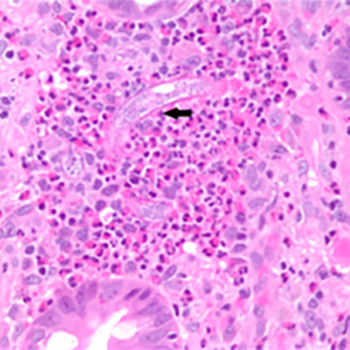Keywords
Colitis, pseudopolyposis, Strongyloides stercoralis, pedunculated polyps
Abstract
Introduction: Strongyloidiasis is a systemic disease caused by the nematode Strongyloides stercoralis. Strongyloides is unique among parasites in that it can remain undetected for decades. Although patients may present with the typical symptoms of a skin rash, cough or diarrhoea, a rare manifestation of infection is pseudopolyposis in the colon. This case highlights the unique finding of pseudopolyposis in a patient with strongyloidiasis with negative stool studies.
Case description: We present the case of an 81-year-old man with a delayed diagnosis of strongyloidiasis. The patient initially presented to the clinic for evaluation of productive cough and was treated empirically for bronchitis. He subsequently developed vomiting and diarrhoea with imaging revealing circumferential wall thickening of the ascending colon, consistent with colitis. Although stool tests were negative, the patient was treated with antibiotics, and then underwent a colonoscopy which revealed multiple polyps. Biopsy results confirmed Strongyloides infection. The patient was treated with ivermectin and improved.
Discussion: This case describes the unique finding of colonic pseudopolyposis in a patient infected with Strongyloides in rural southwest Virginia. Strongyloidiasis is often misdiagnosed due to its non-specific gastrointestinal symptoms and the chronic nature of the disease. Although stool studies are routinely negative for parasitic infection, CT scan findings suggestive of colitis should be followed by colonoscopy with biopsy of any abnormal lesion in the right clinical context. Determining the definitive diagnosis in a timely manner is crucial for establishing the specific treatment and for resolution of the disease.
References











